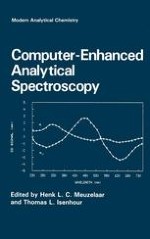1987 | OriginalPaper | Chapter
Curve Fitting and Fourier Self-Deconvolution for the Quantitative Representation of Complex Spectra
Authors : Peter R. Griffiths, John A. Pierce, Gao Hongjin
Published in: Computer-Enhanced Analytical Spectroscopy
Publisher: Springer US
Included in: Professional Book Archive
Activate our intelligent search to find suitable subject content or patents.
Select sections of text to find matching patents with Artificial Intelligence. powered by
Select sections of text to find additional relevant content using AI-assisted search. powered by
Most techniques for multicomponent analysis require spectral features due to each component to be distinguished in some manner. Many of these methods are based on minimizing the standard deviation between the measured spectrum and a synthetic spectrum. The latter spectrum may be synthesized from a linear combination of spectra of mixtures of known composition, as it is in whole spectrum curve-fitting techniques(1,2) or the K-matrix method,(3) or it may be completely synthetic, i.e., generated from the combination of N bands of known shape with different center wave numbers, v̄i0, peak absorbances, A i , and widths, γ i .(4,5) (In this chapter γ will be defined as the full width at half-height.) The greater the dissimilarity of the spectra of each component, the more accurately may least-squares techniques be applied. Conversely, when absorption bands are located so close together that all spectral features are completely unresolved, least-squares methods tend to break down.
